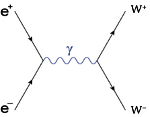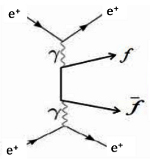Do you have a specific question about the International Linear Collider? Are you curious to know more about its dimensions, qualities, or how exactly it will revolutionise your understanding of the universe? If so, type in your question in the form below and we will post the answers here soon! Please provide your full name, profession (optional), e-mail , and country of residence when submitting your question!
Questions
Q: I have read that the ILC (or CLIC, which ever is built) will "augment" the LHC, providing a level of precision not possible with The LHC. How will the ILC or CLIC, with electrons and positrons, augment anything done in the LHC with protons?

A: Both the LHC and the linear collider (ILC or CLIC) will probe physics processes at distances smaller than 1/1000 of the size of an atomic nucleus. The LHC will study collisions of quarks and gluons; the linear collider will study collisions of electrons and positrons. As you note, the linear collider experiments will study simpler, more elementary, processes and will achieve a higher level of precision.
Still, the two programmes are closely related. There is a basic set of elementary particles in nature. We know some of these particles – the quarks and leptons, the photon, the gluon, and the W and Z bosons – and there probably are others yet to be discovered. These particles can be produced both in quark-gluon and in electron-positron reactions. The LHC and the linear collider give different methods for producing and studying the same particles. The LHC is already operating, so it gives us a chance today to discover new particles and to study properties of the known particles. The linear collider, with its higher level of precision, will add another layer of knowledge. It has the opportunity to reveal new details, and, even new particles that are invisible to the LHC experiments.
Many examples have been studied in the scientific literature.
One is that of the top quark, the heaviest particle of the Standard Model of particle physics. As such, it couples most strongly to the mysterious forces that generate the masses of elementary particles. The top quark was discovered at Fermilab’s Tevatron in 1995. The Tevatron experiments have now produced tens of thousands of top quarks. Most of the results are consistent with the Standard Model picture of the top quark as a structureless elementary particle coupling only to the strong, weak, and electromagnetic interaction, though there is some evidence – not yet conclusive – that the top quark also couples to an additional force. The Tevatron experiments will be repeated with larger data sets at the LHC. At the linear collider, we will carry out a new, more direct, experiment, the elementary production of top quarks and antiquarks by annihilation of electrons and positrons. This will probe very sensitively the coupling of the top quarks to the weak and electromagnetic interactions. These measurements could well reveal new interactions of the top quark that cannot be observed in quark and gluon reactions.
A second illustrative example involves dark matter. The most attractive theory for the mysterious dark matter that makes up 80 percent of the mass in the universe is that this matter is composed of heavy, neutral, stable, weakly interacting particles, or WIMPs. One of the goals of the LHC experiments is to produce these WIMPs, if they exist, and measure some of their properties. At the LHC, the dominant reaction that would produce WIMPs is gluon-gluon annihilation to some heavy strongly-interacting particles that then decay to WIMPs. The WIMP, being weakly interacting, is invisible to the LHC detectors. So experimenters would observe complex events with some obviously missing components and try to infer the properties of the missing elements from what they observe. At the linear collider, we would look for reactions in which electrons and positrons annihilate to electrically charged particles that then decay to WIMPs. The reactions that we would study are much simpler, and at the linear collider we would be able to measure all visible products of the reaction with high precision. This would be a qualitative advantage in inferring the properties of the WIMP.
If WIMPs exist, there are many things we would like to know about them. Most importantly, we would like to know about the weak interactions of WIMPs. This knowledge is essential if we would like to understand how many WIMPs were created in the Big Bang, and whether this density of WIMPs agrees with the dark matter density observed today by astronomers. The detailed information needed to address this question is beyond the reach of the LHC experiments. The new information that the linear collier will provide would be essential to determine whether or not the particle we observe in the laboratory is the same as the one that fills the cosmos.
Michael Peskin
SLAC
Convener of the Physics Common Task Group
Posted: 15 February 2012
Q: What would happen if positrons and positrons collide with each other instead of electrons and positrons?

A: When two fundamental particles collide the possible resulting outcomes depend on the properties of the colliding particles, or in particle physics language, on their quantum numbers. For example, the electric charge on a positron and an electron are opposite, so they can merge into energy (or a photon) with the charge cancelling, and reappear after merging as two particles with opposite quantum numbers. Such collisions are referred to as annihilation. After the collision we might find a quark and an antiquark coming from the interaction, or we might find two W bosons, a W+ and a W-. Here is a Feynman diagram illustrating such an interaction:

What this Feynman diagram represents is the collision of the electron and positron coming in from the left, combining to form the “intermediate state”, the photon, and producing the two outgoing charged particles, the W+ and the W-. However, when two positrons collide the total electric charge of the interaction is +2, so they cannot merge into a charge neutral photon. Rather, they may interact through the exchange of gauge bosons carrying fundamental forces. For example, a photon (the gauge boson of the electromagnetic force) can be transferred from one of the positrons to the other (exchanged), causing the two positrons to scatter in new directions. Here is a Feynman diagram illustrating such an interaction, with the two positrons coming in from the left of the diagram:

Another way they may interact is for each of the positrons to emit a photon, and then the two emitted photons can interact to produce particles. Interestingly, the two photons do not interact directly, but indirectly as illustrated in the Feynman diagram to the left.  In this case the positrons would survive the collision with reduced energy, along with the new particles.
In this case the positrons would survive the collision with reduced energy, along with the new particles.
Such interactions are called two-photon events. You see after the collision two positrons remain along with the newly created particles, labelled in this Feynman diagram.
Jim Brau
University of Oregon
Co-chair of the Worldwide Study and regional detector contact for the Americas
Posted: 1 September 2011
Q: How many particles in a bunch? Is there a set of initial conditions or a desired outcome to determine the size of the bunch? I have read articles with the bunch terminology used but never a particle amount or energy assigned to the term.
A: Hi, my name is Sebastian Aderhold and I currently work on my PhD thesis in the field of accelerator physics at DESY. The nominal number of particles per bunch for the ILC is 2x1010, i.e. 20 billion. It is foreseen to have "bunch trains" of 2625 bunches with 20 billion particles each, with a repetition rate of 5 times per second. The electrons are created by illuminating a photocathode with a laser, and thereby freeing electrons via the photo-effect. Creating the positrons that are accelerated in the other half of the ILC before colliding with the electrons, is somewhat more complicated. On its way to the collision point, the main electron beam is used to create high-energetic photons. These photons hit a metal target, producing a shower of different elementary particles. The positrons are separated from this shower and accelerated to the collision point, where they "meet" the electrons. If you would like to learn more about the details of the positron source you find them in chapter 2.3 of the Reference Design Report, Volume 3 (Accelerator) or in one of the articles from ILC NewsLine.
Sebastian Aderhold
DESY, Hamburg, Germany
Posted: 28 May 2010
Q: Is the International Linear Collider still in consideration at Fermilab in Illinois?

A: The current political and financial situation means that in the US, the goal of the ILC program is to "position US to be a significant partner at the 10-20% level in a global off-shore ILC, should it go forward." A country with an involvement at this level in a global project cannot be its host, so it is unlikely that the ILC would be built at Fermilab. That said we have been careful to avoid any actions to date which would preclude the siting of the ILC at Fermilab should the US government change its stance. We have studied the local geological conditions around Fermilab sufficiently well to know that it is feasible to build the ILC at Fermilab. We have studied different construction scenarios so that we can compare their advantages and disadvantages, and the Fermilab construction scenario would most likely be a 'deep machine' — some 100 metres or 300 feet underground.
Here is a report from the Fermilab Citizens' Task Force on building the ILC there that might be interesting if you're looking for further reading.
Mike Harrison
GDE Americas Regional Director
Posted: 21 May 2010
Q: I know one potential site for the ILC is Fermilab in the US, what are the other potential sites for the ILC?
 A: Outside the United States, there are several potential sites in Europe (Germany, Switzerland and Russia) and in Japan too. As you may know, we are currently in the process of writing a Technical Design of the ILC that will be published in the next years, when first results from the LHC point to an energy range for the next-generation collider. Once governments and funding agencies have agreed on the ILC project, the host bidding process can start and then a site will be chosen.
A: Outside the United States, there are several potential sites in Europe (Germany, Switzerland and Russia) and in Japan too. As you may know, we are currently in the process of writing a Technical Design of the ILC that will be published in the next years, when first results from the LHC point to an energy range for the next-generation collider. Once governments and funding agencies have agreed on the ILC project, the host bidding process can start and then a site will be chosen.
If you want to keep up to date with what's happening at the ILC, subscribe to our weekly newsletter.
Perrine Royole-Degieux
ILC Communications Europe
Posted: 11 May 2010
Q: What is the benefit to invest in a project such as the ILC when a similar undertaking, specifically the Superconducting Super Collider, was cancelled?

A: My name is Harry Weerts, I am a particle physicists at Argonne and involved in ILC. Here is my best answer to your question: HISTORY: From a scientific point of view, the Superconducting Super Collider (SSC) would have been the correct machine to build for particle physics. It was canceled for political reasons and because cost was not under control.
PHYSICS: The SSC and the ILC are very different machines. Let me explain: Had the SSC been built, then by now we might have seen the new physics signatures which we all expect, but have not seen yet. Then the ILC would have been the next machine to build to exactly pinpoint and understand the underlying physics. The SSC would have seen new signatures, the ILC would be needed for exactly understanding what the new physics is.
The SSC was not built, but we have strong reasons to believe that the physics is still there. Currently our expectation is that the Large Hadron Collider at CERN will play the role of the SSC and point to new physics. The LHC will start running in 2008 and we hope to see the signs of new physics soon after that. If there is new physics, the scientific case for the ILC will be very strong and needs to be made, even if we think that there is a finite chance it may not be approved because of political or financial reasons( like the SSC). As scientists we have to make the case and try.
Harry Weerts, Argonne
Q: How can colliding electrons and positron together lead to the discovery of "extra" dimensions? If these extra dimension exist how will the physics be able to confirm the discovery of these dimensions?
A: One basic collision process at the ILC is that an electron annihilates with its antiparticle the positron to form a high energy state of (electroweak) energy. This energy can be then be converted into other particles. Some of these particles may have the ability to move in more spatial dimensions than ordinary matter, and may literally disappear into the extra dimensions. Such events could be detected as "missing energy" using the same methods that we use to detect the presence of neutrinos in high energy collisions.
Another possibility is that at very high energies the electrons themselves may be able to move in extra dimensions. In this case the electrons will seem to have turned into heavier particles, because we will interpret the kinetic energy that they have from moving in the extra dimension as part of their mass. The electrons don't disappear because in this case the extra dimensions are something like tiny circles and our detectors just don't resolve them.
The experimental techniques needed for these kind of searches have already been used at the LEP accelerator at CERN, the HERA accelerator at DESY, and the Tevatron collider at Fermilab. So far no evidence for extra dimensions has been seen.
Joe Lykken, Fermilab
Q: Why is it desirable to build the ILC in a linear format rather than in a cyclotron format?

A: I am a physicist at DESY. We are heavily involved in the worldwide ILC collaboration together with our friends in the US, in Asia and in the rest of Europe.
So why should the ILC be linear? The answer has indeed something to do with the sort of particles we want to accelerate. Electrons and positrons are the lightest charged particles we know. And nature dictates some laws, which we have to obey when we want to accelerate them. First of all, any electric-charged particle, which is forced on a bent trajectory, radiates. So if you take an electron and let it go around a curve, it will emit radiation, which you can imagine as a special kind of light. Depending on the energy of the electron, this radiation can be anything starting from infrared via the visible light spectrum up to the x-ray regime. This kind of radiation is also called Synchrotron Radiation, as it was first observed on synchrotrons (a special kind of accelerator).
This is in fact quite useful, as this radiation comes in handy when looking into matter, e.g. x-raying crystals, etc. Particle accelerators are in fact the brightest light sources available. And a lot of particle accelerators are being built these days to do exactly that.
For us particle physicists this effect, however, is a problem. The radiation takes away energy from the particles we want to accelerate. And the higher the energies get, the higher is the radiation loss. The only work-around would be to increase the size of the rings (as the radiation loss is inverse proportional to the inverse radius of the machine).
And this is the reason why from certain energy regimes onward it makes no sense to stick with circular accelerators. One example: the largest electron-positron collider so far was LEP which existed at CERN until the year 2000. It was a 27 km ring accelerating particles up to 104 GeV (providing collision energies of 208 GeV). If one would try to build a circular accelerator with an energy reach of say 500 GeV collision energy, one has to build a ring with a circumference of more than 600km to cope with the energy losses.
So if we want to avoid that, we go linear. No curves means no synchrotron radiation. This seems to be easy. But we have to pay a high price for that. In a circular machine you need to accelerate the particles just at a quite small part of the machine. The particles circulate, so they pass your accelerating structures every turn and gain energy. In a linear accelerator one has to fill the whole machine with these accelerating structures. This makes the ILC the most complex machine which will ever be built.
One final word: All I said before is just true for electrons and positron (which are very light particles). The synchrotron radiation emission depends heavily on the mass of the particles (it is inverse proportional to the mass^4). So if one accelerates protons (which are about 2000 times heavier than electrons) one can still go for a circular machine. And this is what is happening at CERN right now. They are installing a proton-proton collider in the old LEP tunnel (27 km), called the Large Hadron Collider (LHC), which turned on September 2008.
Karsten Buesser, DESY
